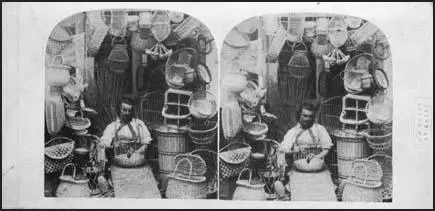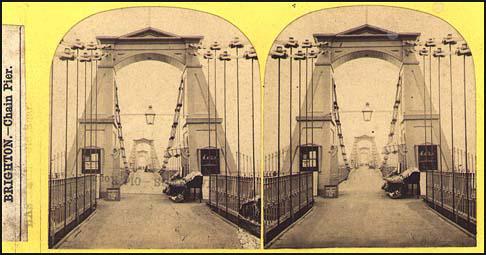Stereoscopic
Photographs
In
1838, the English scientist and inventor Sir Charles Wheatstone
(1802-1875) had described the phenomena of binocular vision and
designed apparatus which fused two separate drawings into a single
three dimensional image. To describe this viewing instrument,
Wheatstone coined the term "Stereoscope" (from the Greek
words 'stereos' meaning "solid" and 'skopein' meaning
"to look at") With the advent of photography, Wheatstone's
reflecting stereoscope, which utilised mirrors, could be used
to view a pair of almost identical photographs and give the illusion
of depth.
Sir David Brewster (1781-1868), a Scottish physicist, designed
a stereoscope that employed two lenses which mimicked binocular
vision. Jules Duboscq (1817-1886) a Parisian optician constructed
an improved stereoscope based on Brewster's design, which merged
two photographs of the same subject to form a three-dimensional
picture.
At the Great Exhibition of 1851, Queen Victoria was particularly
impressed by Duboscq's stereoscope and the accompanying stereoscopic
photographs. Queen Victoria's interest in the stereoscope
signalled the start of a popular demand for stereoscope viewers
and stereoscopic photographs. In 1856, Brewster reported over
half a million of his stereoscopes had been sold.
A few stereoscopic talbotypes had been made for Wheatstone soon
after the introduction of photography in 1839. In the early 1850s,
however, most of the early stereoscopic photographs were daguerreotypes.
Duboscq had displayed a set of his own stereoscopic daguerreotypes
at the Great Exhibition of 1851. In 1853, Antoine Claudet
patented a folding stereoscope which could view stereo daguerreotypes.
A couple of years after the Great Exhibition of 1851 stereoscopic
photography arrived in Brighton. In 1853, Thomas Rowley,
Optician to the Sussex and Brighton Eye Infirmary, was advertising
his "superior selection of stereoscopes with Daguerreotype
plates, Collodion and Photographic Pictures" which could
be hired from his premises at 12 St James Street. In November
1853, Robert Farmer of the Daguerreotype Rooms, 59 North
Street was offering to provide a "stereoscopic Portrait,
with Stereoscope, 10s 6d, complete." Lewis Dixey,
Optician and Dealer in Photographic Apparatus, announced in 1854
that he could supply "Stereoscopes & Stereoscopic subjects
in Calotype, Daguerreotype & Collodion or Glass." George
Ruff of 45 Queens Road, Brighton specialised in stereoscopic
portraits in colour.
Stereo Cards
The reflective surface of a silvered copper plate was not ideal
for stereoscopic effects and the process did not lend itself to
the manufacture of large quantities of stereo pictures. With the
advent of the collodion glass negative and photographic prints
on albumenized paper in the mid 1850s, the mass production of
stereo cards became possible.
The London Stereoscopic Company, founded in 1854 by George
Swan Nottage, was a firm that specialized in the mass production
of stereoscopic photographs. Nottage's company responded to the
enormous demand for stereoscopes and stereo cards. By 1856, The
London Stereoscopic Company had sold over 500,000 stereoscopes
and had 10,000 titles in its trade list of stereo cards. Two years
later, in 1858, The London Stereoscopic Company claimed to have
100,000 stereo cards in stock [ George Swan Nottage (1823-1885)
had connections with Brighton. He owned property in the town and
was a regular visitor to Brighton. At the time of the 1861 Census
George Swan Nottage was residing at 15 Marine Parade, Brighton
and when he died in April 1885, he had just returned from an Easter
holiday at the seaside town.]
In 1857, The Brighton Stereoscopic Company based at 121
St James Street, near the Old Steine was selling stereoscopes
from half a crown (2s 6d/121/2 p) and stereoscopic views were
on sale at a shilling (1s/10 p) each.
The fashion for collecting and viewing stereoscopic photographs
reached its peak in the early 1860s. In 1862 alone, The London
Stereoscopic Company had sold a milliion stereoscopic views.
A wide variety of stereoscopic images could be purchased - views
of faraway places, (Japan, The Andes) scenes of everyday life,
anecdotal pictures, humorous tableaux scenes, 'still life' arrangements
and pictures of life in town and country.In 1858, Samuel Fry,
a photographic artist based at 79 Kings Road, Brighton,even produced
a "Stereograph of the Moon"
Some of the stereoscopic views sold in Brighton were of purely
local interest.
In March 1863, William Cornish junior of 109 Kings Road,
Brighton was advertising a set of six stereoscopic photographs
of a decorated railway shed. The 531 ft. long railway shed was
used to house 7,000 school children who had gathered for a meal
to celebrate the marriage of Edward, Prince of Wales and Princess
Alexandra of Denmark. Stereoscopic views of the decorated railway
shed could be purchased singly for one shilling (10 pence) or
the customer could buy a complete set for 6 shillings
William Mason junior, the son of W.H.Mason, printseller
and proprietor of the Repository of Arts in Brighton's Kings Road,
photographed scenes featuring local craftspeople, such as basketmakers,
and issued them as stereographic cards.

Stereocard
of a Brighton Basketmaker by W H Mason junior (c1862)
More typically, the Brighton artist Edward Fox, who specialised
in landscape photography, advertised "local views as stereoscopic
slides." Familiar landmarks in Brighton, such as the Royal
Chain Pier and the Royal Pavilion became popular subjects for
stereo cards.Some of Edward Fox junior's stereoscopic slides featured
particularly dramatic scenes. Fox's titles included " The
Chain Pier During a Gale " and " Chain Pier by Moonlight".

Stereocard of the Chain
Pier, Brighton c1870
CLICK HERE TO CONTINUE
The Carte de Visite Format